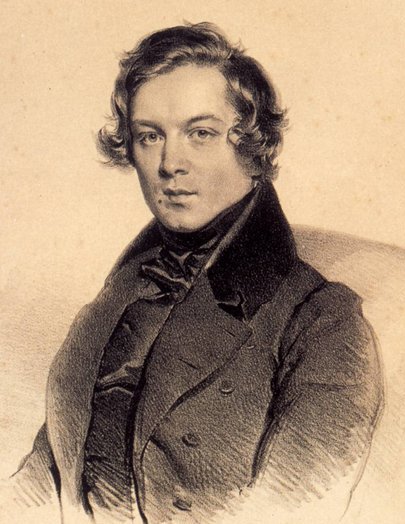|
||
|
As a child Robert Schumann was a prodigious pianist. His teacher and reluctant father in law, Friedrich Wieck, believed that he could become the greatest pianist in Europe. Sadly an injury to his right hand put an end to his ambitions as a pianist. As a student the seeds of his orchestral compositions were clearly being sewn. On one occasion he said to Wieck "If you only knew how I feel driven and spurred on, how my symphonies could already have reached opus 100 if only I had written them down, and how comfortable I feel with the orchestra". However it was not until he reached the age of thirty that his first symphonic masterpiece emerged. In the meantime he wrote mainly piano works, and studied the symphonies of Beethoven intently. In 1838 he came, by a lucky chance, upon the score of Schubert's ninth symphony, which at that time had not been performed. It seemed to act like a spur on him. He wrote "It is the greatest instrumental work to have been written since Beethoven. It spurred me on again to attempt a symphony". He began writing the spring symphony on January 23rd 1841. Four days later, he wrote "Hurrah! Symphony completed!", though the orchestration took him another three weeks to complete. The first performance was given on the 31st March 1841 in Leipzig, conducted by his friend Felix Mendelssohn. The time of composition seems to have been one of the happiest of his life. In the previous year he had finally married Clara. He gave the symphony its title, describing it as a "spring of love". He later told the conductor Wilhelm Taubert "Try to infuse some longing for spring into the playing of your orchestra; this is what I felt when I wrote it". The symphony, in common with Schumann's other large scale works, is composed through a process of motivic development. The first movement opens with a grand fanfare played by the brass. The same motif begins the allegro section with the same rhythm and melodic shape, but around four times the speed. As the movement progresses it is extensively used in many different harmonic contexts, always propelling the music forward. Schumann, however, did not stick slavishly to cerebral composition. Towards the end of the first movement he introduces an unrelated lyrical melody of great beauty. In the second movement we hear most strongly Schumann's longing for the spring. It is a largetto based on a haunting and nostalgic melody played at first by the violins. This melody appears twice more in the movement, the second appearance played with lyrical beauty by the cellos. The contrasting episodes add elements of drama and doubt. At the close of the movement the trombones sound a distant poignant note of nobility. The third movement returns us suddenly to the drive and energy of the first. It is a scherzo with two trio sections, and a coda in which the movement winds down to a quiet calm finish - but not for long. The final movement opens in a blaze of orchestral colour, depicting the arrival of spring. A rising scale theme for the whole orchestra is contrasted immediately by a fast infectiously excited tune played at first by the strings. These two ideas are developed throughout the movement in an unfaltering expression of joy and love of life.
The Spring Symphony was performed by the Portobello Orchestra on the 21st March 2015, conducted by William Church. back |

